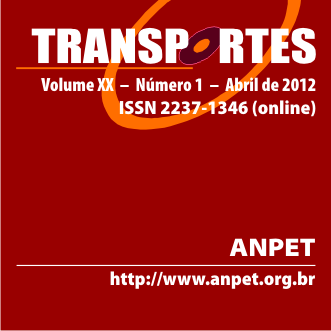Metodologia para avaliação dos fatores condicionantes da velocidade em regime livre em ambiente periurbano
DOI:
https://doi.org/10.4237/transportes.v20i1.547Abstract
Neste artigo, apresenta-se uma metodologia para a avaliação macroscópica da influência das características geométricas e ambientais e da sinalização de velocidade limite legal na velocidade em regime livre praticada pelos condutores em zonas periurbanas ou de transição. Um condutor circula em regime livre quando a sua escolha de velocidade não é condicionada pela presença do veículo precedente. Assim, a velocidade adotada reflete a sua resposta face às características da estrada e do ambiente envolvente. A metodologia consiste na utilização de métodos estatísticos de análise de dados multivariados, nomeadamente de classificação e de análise em componentes principais, para a definição de variáveis macroscópicas caracterizadoras das zonas periurbanas, sobre as quais é depois efetuada uma análise de regressão que permite a avaliação dos impactos das diferentes variáveis na velocidade em regime livre. A metodologia proposta é aplicada a um conjunto de 27 locais pertencentes a estradas de duas vias situadas em Portugal, onde foram observadas as velocidades praticadas, a existência de sinalização de limite legal de velocidade e diversas variáveis microscópicas caracterizadoras da geometria e do ambiente.
Abstract: This paper presents a new methodology for the evaluation of the effects of posted speed limit, geometric and environmental characteristics on free-flow speed in transition zones, through a macroscopic analysis. A vehicle travels under free-flow conditions if its chosen speed is not affected by the presence of the vehicle ahead. In this sense, the free-flow speed reflects the driver’s response to road geometric and environmental characteristics. In the first stage of the proposed methodology, new macroscopic variables reflecting the characteristics of transition zones are created through the use of multivariate data analysis techniques, namely analysis of clusters and principal component analysis. In the second stage, a regression analysis is performed in order to compare the effects of different variables on the adopted free-flow speed. This methodology is then tested for a set of 27 sites located in Portuguese two-lane highways, where drivers’ speed, the existence of posted speed limit and some geometric and environmental microscopic characteristics were collected.
Downloads
Downloads
Published
How to Cite
Issue
Section
License
Authors who submit papers for publication by TRANSPORTES agree to the following terms:
- The authors retain the copyright and grant Transportes the right of first publication of the manuscript, without any financial charge, and waive any other remuneration for its publication by ANPET.
- Upon publication by Transportes, the manuscript is automatically licensed under the Creative Commons License CC BY 4.0 license. This license permits the work to be shared with proper attribution to the authors and its original publication in this journal, and to be adapted for non-commercial purposes, provided appropriate credit is given and any derivative works are distributed under the same terms.
- Authors are authorized to enter into additional separate contracts for the non-exclusive distribution of the version of the manuscript published in this journal (e.g., publishing in an institutional repository or as a book chapter), with recognition of the initial publication in this journal, provided that such a contract does not imply an endorsement of the content of the manuscript or the new medium by ANPET.
- Authors are permitted and encouraged to publish and distribute their work online (e.g., in institutional repositories or on their personal websites) after the editorial process is complete. As Transportes provides open access to all published issues, authors are encouraged to use links to the DOI of their article in these cases.
- Authors guarantee that they have obtained the necessary authorization from their employers for the transfer of rights under this agreement, if these employers hold any copyright over the manuscript. Additionally, authors assume all responsibility for any copyright infringements by these employers, releasing ANPET and Transportes from any responsibility in this regard.
- Authors assume full responsibility for the content of the manuscript, including the necessary and appropriate authorizations for the disclosure of collected data and obtained results, releasing ANPET and Transportes from any responsibility in this regard.









